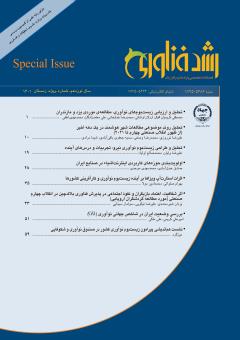تحلیل و ارزیابی زیستبومهای نوآوری، مطالعهی موردی یزد و مازندران
محورهای موضوعی : انتقال فناوري و تجاريسازي پژوهشمصطفی کریمیان اقبال 1 , اردلان اوشانی 2 , محمدرضا خدابخشی 3 , علی معتمدزادگان 4 , محمدمهدی لطفی 5
1 - دانشگاه تربیت مدرس
2 - شرکت توسعه پردازان نادین ویژن
3 - شرکت توسعه پردازان نادین ویژن
4 - دانشگاه علوم کشاورزی ومنابع طبیعی
5 - دانشگاه یزد
کلید واژه: زیستبوم نوآوری, مدل جنگل بارانی, کارت امتیازی, یزد, مازندران.,
چکیده مقاله :
امروزه نوآوری، انعطافپذیری و آمادگی برای تغییر، مهمترین فاکتورهای توسعهی اقتصادی در کشورها محسوب میشوند. بررسی تجربیات سایر کشورها و رویکردهاي نوین دنیا درخصوص توسعهی پایدار مبتنی بر نوآوری، این نکته را گوشزد میکند که حرکت به سمت اقتصاد دانشبنیان، مستلزم شناخت نوآوري است. از طرفی، نوآوري فرایندي پیچیده است و براي رسیدن به یک فضاي کسبوکار نوآور و پایدار، میبایستی مجموعهاي از بازیگران، عوامل، زیرساختها، قوانین و همینطور مجموعهاي از هنجارها و قواعد در کنار هم وجود داشته باشند و بتوانند به خوبی با هم تعامل کنند. چنین مجموعهای، رفتاری مشابه زیستبومهای طبیعی دارد که در آن هر یک از اجزا بر هم اثرگذارند. لذا، در سالهای اخیر، مدلی برای توصیف زیستبومهای نوآوری معرفی شده است که مدل جنگل بارانی نام دارد. در این مقاله، سعی شده است تا به تشریح رفتار زیستبومهای نوآوری از منظر این مدل پرداخته شود. این مدل، ابزاری را تحت عنوان کارت امتیازی جنگل بارانی در اختیار قرار میدهد که سنجهی مناسبی برای ارزیابی و تحلیل زیستبومهای نوآوری است. بنابراین در بخش دوم این مقاله، به ارزیابی و تحلیل دو زیستبوم نوآوری یزد و مازندران بر همین اساس پرداخته شده است. نتایج این بررسی نشان میدهد که زیستبوم نوآوری یزد از نظر سختافزاری به مراتب وضعیت بهتری نسبت به بعد نرمافزاری و فرهنگ حاکم بر زیستبوم دارد. اما در مازندران، هر دو حوزهی سختافزاری و نرمافزاری زیستبوم کمابیش مشابه یکدیگرند و نیاز به تقویت دارند.
Today, innovation, flexibility and readiness for change are the most important factors for economic development in different countries. Examining the experiences of other countries and the new approaches of the world regarding sustainable development based on innovation, points out that moving towards a knowledge-based economy requires the recognition of innovation as the main factor. On the other hand, innovation is a complex process, and in order to achieve an innovative and sustainable business environment, a set of actors, stakeholders, infrastructures, policies, as well as a set of norms and rules must exist together and be able to interact well with each other as a network. Such a complex environment has a behavior similar to natural ecosystems, where component interacts with each other. Therefore, in recent years, a model has been introduced to describe innovation ecosystems, which is called the rainforest model. In this article, an attempt has been made to describe the behavior of innovation ecosystems from the perspective of this model. This model provides a tool called the rainforest scorecard, which is a suitable measure for evaluating and analyzing innovation ecosystems. In the second half of this article, the evaluation and analysis of two innovation ecosystems of Yazd and Mazandaran provinces have been done using this model. The results of this survey show that the Yazd innovation ecosystem is in a much better condition in terms of hardware than the software aspect and the culture that dominates the ecosystem. But in Mazandaran, both the hardware and software parameters of the ecosystem are more or less similar to each other and need to be strengthened.
1- V. W. Hwang and G. Horowitt, The rainforest: The secret to building the next Silicon Valley, California: Regenwald Los Altos Hills, 2012. #
2- H. Doss and A. Brett, The Rainforest Scorecard, A Practical Framework for Growing Innovation Potential, T2 Venture Creation, 2015. #
3- Rainforest Alberta, "Rainforest Alberta scorecard 2020 results," 2020.#


